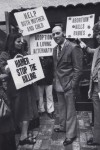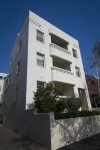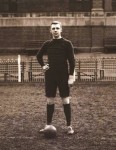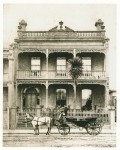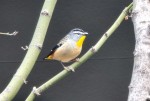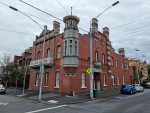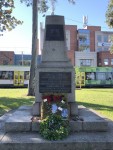More than a Kindergarten
An interesting side-light on the changing demographic of Melbourne in the years after the second world war was the decision to relocate the existing City Free Kindergarten in Exhibition Street (on the corner of Little Lonsdale Street) to Powlett Reserve in East Melbourne.
- Read more
- 345 reads
Jolimont and Repatriation
By 1917 it was apparent that repatriation services for returning service men and women were inadequate. Soldiers were arriving back in the country in large numbers, most of them damaged by illness or injury. Many of them would not be able to return to their pre-war occupations.
- Read more
- 353 reads
The Curious Mr Stanford: from East Melbourne to California
Thomas Welton Stanford arrived in Melbourne in 1860 to make money. He achieved this by quickly securing the sole licence to import Singer sewing machines. But it is not for his business success that he is primarily known.
- Read more
- 1457 reads
Pros and (Mod) Cons
In aid of the Red Cross and War Comforts Funds Melbourne City Council has transformed the Treasury Gardens into a Garden City with an extensive lighting scheme. It will be open on Monday at 1 p.m. for one month, with daily sessions from 10 a.m. to 10 p.m.
- Read more
- 1304 reads
Yarra Park State School Comes Back To Life
Yarra Park State School In East Melbourne was located in a very prominent position - the intersection of Punt Road and Bridge Road. The building that still occupies the site and which housed the former school is familiar to generations of Melburnians who have passed through that intersection on the busy roads north-south and east-west.
- Read more
- 1328 reads
Bedggood: Friendly Footwear
Daniel Bedggood arrived in Melbourne in 1854. Almost immediately he set up a boot and shoe factory in Richmond. A successful business from the start, succeeding generations kept it going and his son, John, oversaw the transition to a new and bigger factory in Jolimont, at 22 Agnes Street, in 1899.
- Read more
- 1226 reads
Mary Gilbert: Melbourne's First Mother
There has been much publicity lately about the large imbalance in the numbers of statues of men as opposed to women in Melbourne. A google search puts it at 580 to 10! One of these ten statues is in the Conservatory in the Fitzroy Gardens, hidden away amongst the foliage.
- Read more
- 1396 reads
Smelling History
Smells trigger memory just as effectively as old photos or objects. Think of some of Melbourne’s more famous smells such as tomato sauce from the old Rosella factory in Richmond, or baking bread from the Capitol Bakery in South Yarra, or even roasting coffee from Quists in Little Collins Street. East Melbourne had its own famous smell emanating from the Victoria Brewery in Victoria
- Read more
- 1562 reads
Dr Julian Smith: surgeon and photographer
One of East Melbourne’s more notable residents was Dr Julian Smith: a remarkable man, famous in two very different fields, surgery and photography. Born in England in 1873, he arrived in South Australia with his family three years later. He studied medicine at Adelaide University but had to transfer to Melbourne when all the instructing medical professionals resigned.
- Read more
- 2492 reads
‘Better to have a loaf on the table than a loaf in the Pub’
The Band of Hope was formed in England in 1847, with a more formal organisation set up in 1855. It was seen by many as a way to develop self-reliance in working men who could use temperance as a means to self-improvement by renouncing alcohol. It was a non-denominational movement, with branches set up by both Protestant and Catholic communities.
- Read more
- 2724 reads
Grand Rank Cabman's Shelter
Cabmen’s shelters had been a feature of London streets since 1875. These little buildings provided much needed shelter for cabmen while they waited for customers. But it was not until 1898 that an anonymous benefactor put up the money to erect the first of Melbourne’s shelters. Architect Nahum Barnet supplied drawings without charge, which were based on one of the London shelt
- Read more
- 3131 reads
The Early Days of Women's Cricket
- Read more
- 3306 reads
Remembering Joyeux
366 Albert St., East Melbourne, lies on the north side of the street between Lansdowne and Clarendon Streets. The house was built in 1909 for the Rev. Llewelyn David Bevan on the land which had once been the garden of the neighbouring house, No 364, which Bevan also owned. The house is built to the footpath, unusual for its time and the East Melbourne area.
- Read more
- 2697 reads
Ormiston Educational Establishment for Young Ladies
East Melbourne from its earliest days was full of schools. The larger, purpose-built church schools eventually grew too big for the small parcels of land available and moved to more spacious suburbs; and the smaller privately run schools generally died a natural death when their principals retired or failed to make a go of it.
- Read more
- 3260 reads
Gone, But Not Forgotten
"Some months ago the parks and gardens committee decided to make the Fitzroy gardens more attractive by erecting a rustic kiosk, where tea coffee and light refreshments might be dispensed. Aided by the Government, a suitable structure was erected in the park and after arrangements had been made, whereby the Misses F. and K.
- Read more
- 2033 reads
A Tale of Two Sisters
Ball and Welch was once one of Melbourne’s landmark department stores, along with others such as Buckley and Nunn. History tells us that the store was founded by Charles Ball and his nephew, William Henry Welch. But perhaps there is more to the story. It is likely that their wives had more than a little to do with the store’s establishment.
- Read more
- 2674 reads
J W H T Douglas: Gentleman Cricketer
With the coming of summer a major event in the East Melbourne area is the Boxing Day Test at the MCG. This year’s match will be between Australia and South Africa.
- Read more
- 1721 reads
Died due to War Service
With Remberance Day coming up it seems a fitting time to acknowledge one of East Melbourne’s many residents who enlisted to serve their King and Country in the Great War. Shown here is Henri Joseph Lamande, in one of the more diverting photos in our society’s collection. For him perhaps there was the added incentive to visit the land of his ancestors.
- Read more
- 1537 reads
Old Men's Shelter
We usually think of public buildings as large and imposing structures such as town halls or railway stations but in Powlett Reserve, East Melbourne there is situated possibly one of the smallest public buildings in Melbourne.
- Read more
- 1753 reads
Dr Bertram Wainer and the Struggle for the Right to Abortion
On 24 June 2022, in the case of Dobbs v Jackson Women’s Health Organisation the U.S. Supreme Court overturned its 1973 ruling, made as result of the now famous Roe v Wade case, that gave a fundamental right to women to access abortion under the Fourteenth Amendment.
- Read more
- 2920 reads
Oscar Oeser - Man of Mystery
In 1946 Oscar Oeser, like many men who had fought in World War 11, migrated to Australia. His arrival had already been announced in an ‘Age’ article of 24 November 1945.
- Read more
- 3312 reads
Kalingra: a story of firsts
East Melbourne is rightfully known for its Victorian era streetscapes. However, between the wars it went through a period of re-development resulting in a scattering of buildings that are markedly different in style.
- Read more
- 2443 reads
George Page Cooper - Art Collector
East Melbourne Historical Society is researching the lives of the names that were on the World War 1 Honour Roll of the old Yarra Park State School that was situated on the corner of Wellington Parade and Punt Road between 1874 and 1987. There are many interesting stories that have come out of this research, and one such story is that of George Page Cooper.
- Read more
- 1566 reads
Salad Days
In the Victorian era when architectural style leaned heavily towards the Italianate one East Melbourne house stood out.
- Read more
- 1620 reads
Joe Pearce - Informant Saw Him Killed
On 17 August 1914 Arthur Mueller ‘Joe’ Pearce enlisted to fight in the Great War. He was the eighth man from Essendon to sign up and the first VFL footballer to volunteer for the war. He had played 152 games for the Melbourne Football Club from 1904-1913, and in a game where players had fixed places on the ground, had kicked five goals. The Argus newspaper nominated him as ‘a
- Read more
- 2140 reads
That was Then, This is Now
If you stand on the corner of Powlett Street and Wellington Parade looking east, there’s the 7-Eleven store, the dry cleaner, a couple of cafes, the Il Duca restaurant and, at the end of the line, the Post Office, an unassuming, utilitarian modern building.
- Read more
- 2977 reads
Vernon Ransford: the elegant left-hander
The holiday season is with us, and top level cricket at the MCG makes its seasonal appearance in the East Melbourne area, the high point being the Boxing Day Test, this year being an Ashes series against England. The MCG was of course the place where Test cricket was born in 1877, and was also the venue of the first One Day International in January 1971.
- Read more
- 2023 reads
Former Yarra Park School
The East Melbourne Historical Society is undertaking a project on the history of the former Yarra Park State school.
- Read more
- 2881 reads
"Art making and art collecting are vitally intertwined and mutually dependent."
Hello fellow East Melbourne community members,
I am seeking a community of people in East Melbourne who love art, and chose to collect art objects for their homes. My name is Kayla, and I live locally on Gipps Street. I am studying Art History and Curation at Monash University. Currently I am working on a curatorial project that will attempt to survey the works of art in homes in East Melbourne. By doing this I aim to initiate a community discourse surrounding art collecting, and explore an alternative method of creative placemaking. I am interested in learning anecdotal local histories through a person's art collection. This project aims to identify why and how East Melbourne locals collect art. I’m keen to understand my local community’s interests when it comes to the art they choose for their homes. I hope to connect with local people with a shared passion for art.
- Read more
- 1561 reads
Spotted: a Spotted Pardalote in Jolimont
This tiny Spotted Pardalote was recorded in a cottage garden in Agnes Street, just up the road from a huge demolition taking place on Jolimont Street. It was nervously flitting between a branch and a small verandah ledge. The noise from the jack-hammers and diggers was too great to hear or record its call. We were quite concerned that its habitat had been destroyed, but a couple of days later we saw it again in the same garden before it flew next door into a much more protected bushy garden. We can only hope that it lives and thrives with its family without further disturbance. See a video at: https://emhs.org.au/catalogue/emdf0455
- Read more
- 1972 reads
Queen Bess Row and Madam Midas
Queen Bess Row, 72-76 Hotham Street, is possibly East Melbourne’s most remarked upon building. Its three red-brick, four-storey houses exhibit a rich decorative scheme of gables and arches which single it out among the smaller and more conservative houses around it.
- Read more
- 2239 reads
Remembering the Great War
On November 11 every year we remember the dead of the Great War and especially our Australian dead, those young men who, in loyalty to England and with a sense of adventure joined up in their thousands, leaving behind families, jobs, friends and thinking they’d be ‘home by Christmas’.
- Read more
- 2282 reads
East Melbourne at Work
East Melbourne in the past was generally regarded as a purely residential suburb with little commercial or industrial activity except for the large and very visible enterprises of the Bedggood shoe factory in Jolimont and the Victoria Brewery in Victoria Parade. But there were a number of smaller highly successful businesses, many tucked away down lanes and behind houses. The firm o
- Read more
- 2601 reads
Dr Samuel Peacock of Eastbourne House
Eastbourne House stands on the corner of Wellington Parade and Simpson Street in East Melbourne. It is a two-storey building of 16 rooms, with a large balcony overhanging Simpson Street, and is classified by the National Trust. It was built for Dr Samuel Peacock in 1902. He used Eastbourne House as a residence, a surgery and a private hospital solely for female patients.
- Read more
- 2757 reads
Harold Parsons Memorial
In mid-May I was crossing the wedge of green space on the north west corner of the intersection of Hoddle Street and Wellington Parade/Bridge Road known as Weedon Reserve. In that small park is a monument to someone who has slipped out of the public memory, but who in his day was a celebrity as a world record-holder in motor cycling events.
- Read more
- 3082 reads
Reach for the Sky
Ask those who live in East Melbourne about the different styles of local architecture and they will identify the rare houses still existing from the 1850s and 1860s, the beautiful long lines of terraces in Powlett St and the iron lace-trimmed free standing mansions which are the pride of the neighbourhood.
- Read more
- 3086 reads
Marching for Justice
On 15 March this year more than 5,000 people gathered in East Melbourne’s Treasury Gardens, many dressed in black, many carrying banners. They streamed up the steps from Parliament station, alighted from trams which had come from all over the city, and walked with determination from the nearby suburbs.
- Read more
- 2194 reads
Valetta - an East Melbourne story
East Melbourne’s first crown land sales were held on 16 June 1852. Prior to this the area had been a popular place for local Aboriginal groups who were attracted to its swamps and lagoons as fishing grounds.
- Read more
- 2800 reads
President's Christmas Letter & Membership Renewal
Dear Members,
It has been a topsy turvy year for us all but thankfully we seem to be headed in the right direction in managing the spread of the COVID virus.
- Read more
- 3510 reads
Streets of fear in city's wealthy enclave

Article in the Australian 24 August 202 midst covid-19
- Read more
- 3685 reads
Reopening of St Peter's Plaza Eastern Hill, 10 November 2019
 On 10 November, St Peter’s Plaza and the restored ‘Cross of Sacrifice’ were re-opened to the public. Dating from 1924, the cross is a memorial to the fallen soldiers of World War 1, modelled on wayside crosses in France and is the only one of its kind in Australia.
On 10 November, St Peter’s Plaza and the restored ‘Cross of Sacrifice’ were re-opened to the public. Dating from 1924, the cross is a memorial to the fallen soldiers of World War 1, modelled on wayside crosses in France and is the only one of its kind in Australia.
- Read more
- 4633 reads
Jolimont Station: submission
The East Melbourne Historical Society has recently nominated Jolimont Station for inclusion on the Heritage Victoria register. The station has been a long overlooked part of our history. It does not appear even on the City of Melbourne's Inventory of Heritage Places.
- Read more
- 4793 reads
Phil Ruthven Slides Available
There was an excellent attendance at our event on Wednesday 21 June 2017 when Phil Ruthven took us on a trip down Memory Lane looking back to Australia, Melbourne and East Melbourne in 1853 and 1953 to the present day. He also had the courage, audacity some might say, to predict what the circumstances might be in 2053.
- Read more
- 6206 reads
Richard Wynne, planning minister, states East Melbourne 'spectacular'
On Monday, March 9 2015 The Age ran an article by Clay Lucas under the headline 'Towers make city hostile. says minister'. In the article Mr Wynne said to have significant concerns over the levels of density that been approved for Melbourne's CBD. Asked about his favourite architecture he listed East Melbourne as one of his choices.
Melbourne City 1931
Directed by F.W. Thring, father of the famous Australian actor Frank Thring.
Includes the Fitzroy Gardens and the Royal Botanical Gardens.
- Read more
- 4933 reads
Dr. Ross McMullin ANZAC Lecture, Wednesday 22 April 2015
Dr. Ross McMullin is an historian and biographer whose major interests are Australian history, politics and sport. He has written extensively on the impact of involvement in World War 1 on Australia.
DOCKLANDS LIBRARY
If you're looking for somewhere new to visit, why not head down to see the new Docklands Library at 107 Victoria Harbour Promenade?
BUNJILAKA ABORIGINAL CULTURE CENTRE
Bunjilaka Aboriginal Culture Centre contains a permanent exhibition, created by a shared enterprise between Museum Victoria and the Victorian Aboriginal Community. It brings together the knowledge, culture, stories, objects and images from the Koorie peoples of Victoria and the wider Aboriginal and Torres Strait Islands communities in an exciting and informative self-guided exhibition.
Help needed for Boer War research
Rob Droogleever has written to us seeking help with research for his new book which is a regimental history of the 5th Victorian Mounted Rifles Contingent in the Boer War.
Joyce Meier: Exhibition of Paintings
 An exhibiton of paintings by Joyce Meier will be held at the Bridget McDonnell Gallery, 130 Faraday Street, Carlton, from 9 to 30 November.
An exhibiton of paintings by Joyce Meier will be held at the Bridget McDonnell Gallery, 130 Faraday Street, Carlton, from 9 to 30 November.
Marvellous Melbourne - Queen City of the South
 A documentary film made in 1910 about the City of Melbourne, then the interim capital cit
A documentary film made in 1910 about the City of Melbourne, then the interim capital cit
Snapped: Melbourne in a moment exhibition at East Melbourne Library
All shortlisted and winning entries from the biennial amateur photography competition, Snapped: Melbourne in a moment, are now on display upstairs at East Melbourne Library.
Drop in and be inspired by the work of our talented entrants.
http://www.melbourne.vic.gov.au/MelbourneLibraryService/Pages/Snapped2012.aspx
When: Monday 14 January to Thursday 28 February
Where: East Melbourne Library, level 1
Help East Melbourne commemorate WW1
In 1914 the world will begin centenary commemorations of the First World War.
Along with many of their fellow Australians people from East Melbourne flocked to enlist. Many were heroes. Many lost their lives or suffered horrific physical or mental injuries. Many at home worked, endured and suffered consequences.
Yarra Park - MCG Responds
 Our continuing campaign to improve the well-being of Yarra Park has achieved some modest improvements of late. Construction vehicles have been causing quite a bit of damage plane trees to the south-western corner near the hump-backed bridge. The cabman's shelter has also been under threat. (See our recent photographic study.)
Our continuing campaign to improve the well-being of Yarra Park has achieved some modest improvements of late. Construction vehicles have been causing quite a bit of damage plane trees to the south-western corner near the hump-backed bridge. The cabman's shelter has also been under threat. (See our recent photographic study.)
In response to telephone calls and emails to the MCG executive office there has been a higher level of consciousness of the issues and some immediate actions to protect some areas. We are hoping for continuing improvements, especially as the footy season gets under way.
Protection of Yarra Park
Is Yarra Park being managed appropriately in accordance with its registration on the Victorian Heritage Register?
The southern corner of Yarra Park is taking a particular beating from car parking this summer. Our new photo record tells the story.
Military History and Heritage Victoria
If you have a strong interest in military history you may be interested in joining Military History and Heritage Victoria which currently has two vacancies on its executive committee. MHHV provides a forum for people and groups who are passionate about military history and heritage in Victoria. It promotes research, preservation, education, and commemoration of Australian and Victorian military history and heritage. Amongst others, MHHV is supported by the City of Melbourne, the RSL and the Shrine of Remembrance. More information can be obtained fron the MHHV web site. If you are interested in joining MHHV or serving on its committee please use the contact form on their site.
EMHS and Planning Applications
EMHS members are invited to contribute their thoughts on the Society's involvement in planning and heritage issues. Follow this link to join the forum.
Pandora's Box
Pandora's Box is to acquire some new contents. And it relates to you! The East Melbourne Historical Society has agreed to a request from the State Library of Victoria for our website to be periodically archived on PANDORA, the web archive of the National Library of Australia. This will improve the accessibility of our website and ensure its continuing availability for future generations - even after your current committee has joined Pandora in Never Never Land.
Premier of Victoria passes the buck on Yarra Park
 The tree versus the bull barThe EMHS referred its photographic essay on the devastation of Yarra Park to the Premier of Victoria. Similar letters were also sent to the Lord Mayor and the local State Member of Parliament, Bronwyn Pike. The Premier's office, unlike the local member, at least gave us the courtesy of a reply. Unfortunately the Premier passed the buck to the Minister for Sustainability and Environment who in turn passed it to one of his divisional heads. By this time the buck, which was already on very thin ice, sank without a trace. The reply we received was a triumph of obfuscation and spurious argument.
The tree versus the bull barThe EMHS referred its photographic essay on the devastation of Yarra Park to the Premier of Victoria. Similar letters were also sent to the Lord Mayor and the local State Member of Parliament, Bronwyn Pike. The Premier's office, unlike the local member, at least gave us the courtesy of a reply. Unfortunately the Premier passed the buck to the Minister for Sustainability and Environment who in turn passed it to one of his divisional heads. By this time the buck, which was already on very thin ice, sank without a trace. The reply we received was a triumph of obfuscation and spurious argument.
Quote of the week
"Widening roads to solve traffic congestion is like loosening your belt to cure obesity,"says Walter Kulash, a traffic engineer from Orlando, Florida - something to keep in mind when contemplating the planned roadworks on Hoddle Street.
Melbourne Heritage Action
Melbourne Heritage Action is a new group created to provide a forum of people dedicated to preserving, protecting and promoting the ongoing use of significant heritage places such as buildings, streetscapes, laneways and interiors in Melbourne. The group wants to encourage owners, developers, architects, academics and businessmen to explore ideas of adaptive reuse and heritage preservation. Founded under the auspices of the National Trust of Victoria, the group advocates for the protection of significant built heritage from all periods, which is threatened by unsympathetic development, demolition or neglect. Their focus is primarily the City centre and has arisen over concerns over the recent demolition of Lonsdale House and the threat to the Windsor Hotel. Anyone wishing to join should go to their website: http://www.melbourneheritage.org.au
Yarra Park at its Lowest Point?
 Yarra Park 2 August 2010The East Melbourne Historical Society has published a gallery of photographs recording the current condition of Yarra Park, perhaps at its worst in living memory.
Yarra Park 2 August 2010The East Melbourne Historical Society has published a gallery of photographs recording the current condition of Yarra Park, perhaps at its worst in living memory.
As many residents of East Melbourne have noticed, car parking in Yarra Park throughout this wet football season has been severely damaging to the Park. As an estimate, 70% of the Park's surface is now down to bare dirt or mud. Scores of trees are damaged, dead or vanished. Trucks and cars are driving over the roots of trees and parking hard up against them. Even the historic Aboriginal trees have only thin, narrow fringes of grass around them. The gallery tells the story quite unambiguously.
To see what you can do, keep reading ...
City of Melbourne Development Strategy 2010
 2010 City of Melbourne Growth FrameworkOur President Jill Fenwick reports on recent correspondence and discussions with the State Government and with the City of Melbourne concerning Yarra Park and developments in the sporting precincts and along the railway lines.
2010 City of Melbourne Growth FrameworkOur President Jill Fenwick reports on recent correspondence and discussions with the State Government and with the City of Melbourne concerning Yarra Park and developments in the sporting precincts and along the railway lines.
The news is not good. (Was there ever a "Good News Week"?) The council denies responsibilty for Yarra Park and the State Government acts as though it is being managed despite the depressing evidence to the contrary. The sporting precinct has become a breeding ground for white elephants. The new City of Melbourne Municipal Strategic Statement is a multiple pregnancy - species unknown.
Lost, Stolen or Strayed - Yarra Park - Forty Shillings Reward
Has anyone noticed? Yarra Park has gone the way of James James Morrison's Mother. She has disappeared! One wonders, was it despite or because of repeated warnings from the National Trust (commonly known as Jim) about green wedgies at the end of Town? In any case, Yarra Park donned her golden gown this autumn - and promptly disappeared from the City of Melbourne's records.
Missed the quiz? Don't worry, John Clarke provides the answers.
And the answer was ...
Punt Road. The other photo shows the Franz Joseph Glacier, where some actual movement has been detected by scientists over the past 600 years.
Also of interest to East Enders ...
Change of scheduled speaker
Greg de Moore was to speak to us on 16 June 2010 about Tom Wills, the co-founder of Australian Rules Football. Unfortunately Greg has had to reschedule. However, John Briggs, a heritage architect, known to many in East Melbourne, has agreed to speak to us on 16 June about heritage conservation, a subject dear to all of us. Please bring your friends but do call Deirdre first!
Yarra Park added to Heritage Register
 Yarra Park 1864In culmination of a long campaign by the East Melbourne Group, the Heritage Council of Victoria has added Yarra Park to the Heritage Register. This means that any major developments will require a permit from Heritage Victoria.
Yarra Park 1864In culmination of a long campaign by the East Melbourne Group, the Heritage Council of Victoria has added Yarra Park to the Heritage Register. This means that any major developments will require a permit from Heritage Victoria.
Rupert Murdoch's "Melbourne Leader" reacted in form. "Heritage listing puts MCG car park under threat," its headline said. It continued, "The future of game-day carparking at the MCG is under a cloud after Yarra Park was added to the state’s heritage register. East Melbourne residents were last week celebrating after a hard-fought campaign to have the park added to the register."
See the full decision of the Heritage Council and the Leader article in our catalogue item, Yarra Park Heritage Listing 2010.
The East Melbourne Historical Society Receives a Special Grant
 Project team members: - Jill Fenwick, Nik Iljin, Wendy BabiolakisThe East Melbourne Historical Society has received a grant of $2,290 from Museums Australia (Victoria) to digitise its collection. Digitising involves creating high quality electronic images of items in the collection and loading them onto the web site. The collection may then be searched or browsed via an on-line catalogue and digitised items can be viewed in detail. The grant provides funds to buy imaging equipment, software and services to begin the process.
Project team members: - Jill Fenwick, Nik Iljin, Wendy BabiolakisThe East Melbourne Historical Society has received a grant of $2,290 from Museums Australia (Victoria) to digitise its collection. Digitising involves creating high quality electronic images of items in the collection and loading them onto the web site. The collection may then be searched or browsed via an on-line catalogue and digitised items can be viewed in detail. The grant provides funds to buy imaging equipment, software and services to begin the process.
Hole plugged in MMBW plans
 Thumb print of missing planA significant hole has been plugged in our set of MMBW plans for East Melbourne. The missing plan covers the area bounded by Grey, Hoddle, Hotham and Powlett Streets. It was drawn in 1899 but had managed to escape digitisation until clever detective work by the State Library Maps Collection uncovered its whereabouts and took it into custody. Its particulars have now been digitised by the Imaging department and it is available in our Gallery where you are free to pan and zoom at your pleasure. As you will see, even after such a long period at large the item is in quite remarkable condition although admittedly a little ragged around the edges.
Thumb print of missing planA significant hole has been plugged in our set of MMBW plans for East Melbourne. The missing plan covers the area bounded by Grey, Hoddle, Hotham and Powlett Streets. It was drawn in 1899 but had managed to escape digitisation until clever detective work by the State Library Maps Collection uncovered its whereabouts and took it into custody. Its particulars have now been digitised by the Imaging department and it is available in our Gallery where you are free to pan and zoom at your pleasure. As you will see, even after such a long period at large the item is in quite remarkable condition although admittedly a little ragged around the edges.
EMHS catalogue is now on-line
The East Melbourne Historical Society catalogue is now on the web site. Just click on the Catalogue menu item at the top right or follow this link: http://emhs.org.au/catalogue.
You can browse the catalogue, search for any terms or look for specific topics, building names or addresses.
If you would like access to any items please don't hesitate to Contact us.
EMHS web site is being upgraded
Our website is undergoing a major upgrade. During the next few days a number of changes will be made which will improve the appearance of the site, accessibility of information, functionality, speed and security. Please accept our apologies for any inconvenience during this process. If you experience any particular problems please contact us or leave a comment below.
19th century MMBW plans of East Melbourne published
 Index to MMBW plansWith the permission of the State Library of Victoria, the East Melbourne Historical Society has published a (nearly) full set of MMBW plans drawn between 1895 and 1900 covering East Melbourne. The easiest way to access the plans is from the Index to MMBW plans.
Index to MMBW plansWith the permission of the State Library of Victoria, the East Melbourne Historical Society has published a (nearly) full set of MMBW plans drawn between 1895 and 1900 covering East Melbourne. The easiest way to access the plans is from the Index to MMBW plans.
The plans are highly detailed showing house outlines, out-houses, facilities, pipes, drains, ground surface types and many other details applying at the time. As a historical record of East Melbourne they are extremely informative and quite unique.
Holy Trinity Centenary 2007
A Talk in Commemoration of 150 years of Anglican presence and the centenary of the consecration of Holy Trinity Church
By Father John Stewart, Vicar, Holy Trinity Anglican Church East Melbourne
Director, The Living Well Centre for Christian Spirituality
Friday 19 October 2007
Public nuisance in Gipps Street
On 6 December 1876 Charles Barthing was summoned under common law to answer a charge that “on the 28th October at Gipps-street, East Melbourne, and on divers days and hours between that day and the date hereof (29th ult.) he did keep and maintain a certain common dancingroom near the dwelling-houses of divers subjects of our lady the Queen, and also divers public streets there, and for his own




















